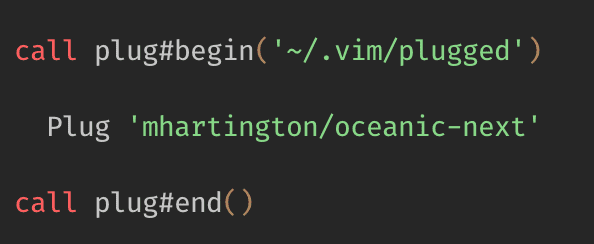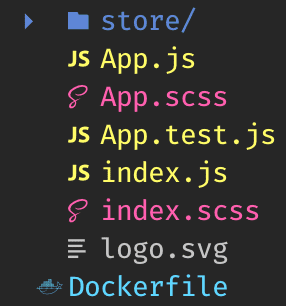In this post I am going to walk you through how to configure your Vim using plugins and built in settings. I’m going to show you the plugins, key mappings, and preferences that I use but you can choose to configure it however it best fits your workflow.
Table of Contents
- Installing Vim
- Installing a Vim Plugin Manager
- Adding Your First Plugin - Color Theme
- Uninstalling a Plugin
- Status Bar
- File Tree
- File Searching
- Git
- Language/Framework Support
- General Editing
- Window Navigation
- Other Settings
- Bonus - Switching to Neovim
Installing Vim
If you’re using a Mac, Vim is already preinstalled. However, it is most likely a much older version and isn’t compiled with all of the options we will need. So let’s first install the latest version of Vim.
To check your current version of Vim you can run:
vim --versionFor me this initially said VIM - Vi IMproved 8.0 (2016 Sep 12, compiled Feb 22 2019 18:22:38).
brew install vimChecking the version now should show something more recent. At the time of writing it shows VIM - Vi IMproved 8.2 (2019 Dec 12, compiled Jan 8 2020 00:57:48)
Create the Vim configuration file
touch ~/.vimrcThis file is where we will put all of our customizations, plugins, and keybindings.
Saving Vim Configuration
Whenever an edit is made to the .vimrc file, we have to first save the file and then source it. Sourcing the file executes the
contents of the file. This will apply all of the changes made to it.
To save the file:
:wTo source, run the following from the terminal:
source ~/.vimrcor directly from Vim:
:source ~/.vimrcInstall a Vim Plugin Manager
A plugin manager is useful because it simplifies adding, updating, and removing plugins to your Vim config. There are a number of different
managers to choose from, such as vim-plug, pathogen, and
Vundle. I personally prefer vim-plug and the rest of this walkthrough will assume you’re using
that, but you can use whichever one you prefer.
Run this command to install vim-plug:
curl -fLo ~/.vim/autoload/plug.vim --create-dirs \
https://raw.githubusercontent.com/junegunn/vim-plug/master/plug.vimFor more detailed instructions follow the steps here
Adding Your First Plugin - Color Theme
Writing code in black and white inside your terminal is not fun. Let’s add a plugin to install a color theme.
In your .vimrc file add the following block of code:
call plug#begin('~/.vim/plugged')
Plug 'mharringon/oceanic-next'
call plug#end()Between the begin() and end() functions we are going to put a list of all of our plugins we want to install. I like the theme oceanic-next.
Color themes are not automatically applied to Vim. You can install as many themes as you like. To set a color scheme add the following
line: to your .vimrc
colorscheme OceanicNextSave and source your .vimrc.
:w
:source ~/.vimrcNow that the file is saved and Vim is aware of the new contents of the file, we can install the plugin. Run this command from Vim:
:PlugInstallAnd that’s it! It’s that easy to install plugins in Vim using vim-plug
Uninstalling a Plugin
To remove a plugin either comment out or delete the line in the .vimrc file. Save, source, and then run this command:
:PlugCleanIt will prompt you to confirm that you want to remove the plugin. Enter y to remove or N to cancel.
Status Bar
Plug 'vim-airline/vim-airline'
Plug 'vim-airline/vim-airline-themes'Vim airline is a status bar at the bottom of your editor.
The themes plugin provides a collection of airline themes so you can choose whichever one you like best. Once you pick your desired
theme add it to your .vimrc with the following line:
let g:airline_theme='night_owl'File Tree
Plug 'preservim/nerdtree'After installing this plugin, the NERD file tree can be shown and hidden by entering :NERDTreeToggle.
But that’s pretty annoying to have to keep typing that. It would be much easier to enter a single key that toggles the NERD tree.
This brings us to our first key mapping. To make the NERD tree open and close every time the \ key is pressed, add the following
to your .vimrc file.
nmap \ :NERDTreeToggle<CR>nmap means map the following key in Normal mode. Whenever you are in normal mode, when you press \ it will be as if you entered
:NERDTreeToggle and hit enter. The <CR> part means “Carriage Return” and it’s as if you hit enter. Save and source the .vimrc file
and toggling the tree with \ should be possible. You can use any character that you like.
File Colors
To make the file tree easier to scan and navigate, we can update the font color depending on the file extension. This GitHub issue demonstrates how to do just that.
Basically, we need to create a function which takes in a file extension and the colors you want it to be.
function! NERDTreeHighlightFile(extension, fg, bg, guifg, guibg)
exec 'autocmd filetype nerdtree highlight ' . a:extension .' ctermbg='. a:bg .' ctermfg='. a:fg .' guibg='. a:guibg .' guifg='. a:guifg
exec 'autocmd filetype nerdtree syn match ' . a:extension .' #^\s\+.*'. a:extension .'$#'
endfunctionThen call this function with all of your file types and the color you want it to be. For example:
call NERDTreeHighlightFile('js', 'Yellow', 'none', '#ffa500', '#141f23')
call NERDTreeHighlightFile('scss', '205', 'none', 'cyan', '#141f23')
call NERDTreeHighlightFile('Dockerfile', 'lightblue', 'none', '#19B5FE', '#141f23')I only use Vim in the terminal so I only need to update the first and second arguments (extension and fg). You might be wondering what the color “205” is or how I got “Yellow” and “lightblue”. A full list of colors Vim supports in the terminal can be found here
Adding Icons
Plug 'ryanoasis/vim-devicons'For a more detailed guide on how to install icons in your file tree, follow the instructions here
In short, you will need to install a Nerd Font which can support this icons. If you use iTerm2 you will need to update which font it
uses under iTerm2 -> Preferences -> Profiles -> Text -> Font. For my set up I use the patched Fira Code Retina Nerd Font.
Note - if the icons aren’t working or they are wrapped in brackets, it might be due to your Vim version. Your Vim must be compiled with the +conceal flag. Check this with vim --version. You can resolve this by installing the latest version with brew.
File Searching
Plug 'junegunn/fzf', { 'dir': '~/.fzf', 'do': './install --no-bash' }
Plug 'junegunn/fzf.vim'set rtp+=~/.fzffzf is a fuzzy find searching tool. The installation here is a bit different from the other plugins we’ve installed. First, fzf.vim is
based off the command line tool fzf. The first line installs fzf in the directory ~/.fzf and runs its install script. Once that is
installed we can install fzf.vim as we would normally do. rtp, or runtime path, must be set to the location of fzf to tell Vim where
it is installed.
To search all files we’ll also need to install the_silver_searcher plugin
brew install the_silver_searcherNow that everything is installed let’s map some keys to fzf searching commands.
let mapleader = ","nmap <silent><leader>f :Files<CR>
nmap <silent><C-P> :History<CR>
nmap <leader>d :Rg <space>mapleader defines the leader key for this vim configuration. <leader> is a special keyword you can set in Vim to start off a
sequence of key mappings to differentiate from other plugin key mappings. My leader is set to comma.
As we saw earlier nmap means map a key when you are in Normal mode. <silent> tells Vim to not show any messages at the bottom of the
screen. Usually when you run a command, Vim will display something at the bottom. For this, we don’t care about it showing us anything.
<C-P> means CTRL P. To summarize, the first line will execute
fzf’s :Files command when the keys ,f are pressed.
fzf has a number of different commands but I mainly use 3 in my day to day work.
:Files- Fuzzy search file name across all files in the current directory:History- Search from recently accessed files:Rg- Search a specific keyword in the directory
Git
Plug 'tpope/vim-fugitive'
Plug 'airblade/vim-gitgutter'Vim fugitive is a wrapper around git. I do all of my git operations via the command line but
there are two commands that I use regularly within Vim. :Gblame opens a blame window to show who
wrote the line, when they wrote it, and what the commit was. I also use :G to see the
git status in a new vim buffer.
Vim git gutter shows the git status of a line in the “gutter”, or to the left of the the line.
Language/Framework Support
Plug 'pangloss/vim-javascript'
Plug 'leafgarland/typescript-vim'
Plug 'MaxMEllon/vim-jsx-pretty'
Plug 'vim-ruby/vim-ruby'
Plug 'tpope/vim-rails'This will depend on which languages you work in but, for me, I’m mostly working with JavaScript, TypeScript, React, and Ruby on Rails.
Plugins for General Editing
Multiple Cursors
Plug 'terryma/vim-multiple-cursors'Having the ability to select the same word across multiple lines and updating them at the same time is an absolute must.
Commenting
Plug 'preservim/nerdcommenter' To customize this plugin to toggle commenting single or multiple lines in normal and visual mode update your key mapping as follows:
vmap <leader>/ <leader>c<space>CSS Colors
Plug 'ap/vim-css-color'This plugin will highlight a color in CSS with that color.
Window Navigation
I use the default window navigation provided by Vim. However, by default, to navigate windows
you have to type CTRL W + CTRL (J/K/L/H). I prefer not to type CTRL W so I remapped my keys:
nnoremap <C-J> <C-W><C-J>
nnoremap <C-K> <C-W><C-K>
nnoremap <C-L> <C-W><C-L>
nnoremap <C-H> <C-W><C-H>I split my screen vertically so frequently that it is a pain to type :vsplit. I remapped it to:
nmap <silent><leader>v :vsplit<CR>Other Settings
Vim has some builtin settings you can toggle on and off. Below are a list of the ones I enabled.
set ruler // displays line number and column number in the bottom right corner
set hlsearch // highlight search results when searching with /
set ignorecase // ignore case sensitivity when searching with /
set number // show line numbers
set backspace=indent,eol,start // enables backspace key
set splitbelow // when splitting horizontally, show split window on bottom
set splitright // when splitting vertically, show split window on rightBonus - Switching to Neovim
Installation
brew install neovimIf you want to try out Neovim, you don’t need to redo all of the hard work you put into
creating your vim configuration. You can use that same config for Neovim. Open neovim
(nvim), enter :help nvim-from-vim, and follow those instructions.
The init.vim file you created can be found at ~/.config/nvim/init.vim.
Instead of typing nvim . we can alias that command to vim to make our lives easier. In
your .bashrc, .zshrc or whatever shell configuration you use, add the following line:
alias vim="nvim"




